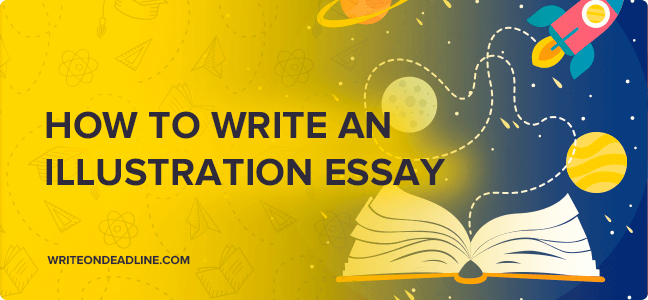How to Write an Illustration Essay

Table of Contents
Introduction to Illustration Essays:
An Illustration Essay: Unveiling the Concept
An illustration essay, often referred to as an exemplification essay, is a piece of writing that employs examples to illustrate a point or show that a particular phenomenon exists. This type of essay is predicated on providing numerous examples to explain or support the main argument.
The Role in Academia
In academic writing, illustration essays play a vital role as they allow students to develop their skills in critical thinking and expression. Through the use of detailed examples, these essays can make abstract ideas tangible and relatable, facilitating a deeper understanding for both the writer and the reader.
Basic Structure: Mapping the Essay
The basic structure of an illustration essay mirrors that of most academic essays and includes three primary components:
- Introduction: Sets the stage for the discussion, introducing the main topic and presenting the thesis statement.
- Body Paragraphs: Each paragraph focuses on a particular example or set of examples that support the thesis statement.
- Conclusion: Summarizes the main points and reiterates how the examples support the thesis, leaving a final impression on the reader.
Choosing a Topic:
Finding Your Illustrative Focus
- Relevance: Ensure the topic is pertinent to the assignment and has enough depth to provide ample examples.
- Interest: Select a subject that is engaging for both you and your intended audience to maintain motivation and curiosity.
Brainstorming the Ideal Topic
- Mind Mapping: Begin with a central idea and branch out into related themes and examples.
- Free Writing: Set a timer and write continuously about potential topics to uncover hidden ideas.
- Lists: Compile a list of possible topics and then narrow down to the most promising ones based on available research and your own interest.
Thesis Statement:
The Core of Your Essay
The thesis statement is a sentence that encapsulates the main argument or point of your essay. It’s the foundation upon which your illustrative examples are built.
Crafting Your Thesis
- Clarity: Your thesis should be clear and concise, telling readers exactly what to expect.
- Focus: It should be specific enough to be covered in the space of your essay but broad enough to allow for multiple examples.
- Argumentative: A good thesis provides a standpoint that your examples will help to substantiate.
Research and Evidence:
Understanding the Backbone of Your Essay
The Significance of Research
Research in illustration essays is not just a formal requirement; it’s the fuel that drives the engine of your argument. It provides the factual basis needed to support your thesis and helps to construct a persuasive, well-informed essay.
Diverse Evidence: Strengthening Your Illustrations
- Statistics: These offer quantifiable data to your argument, providing weight to your examples.
- Anecdotes: Personal stories or observations can add a human touch, making your essay relatable and vivid.
- Factual Statements: Objective information grounded in research that solidifies your argument.
Assessing Source Reliability
- Authority: Consider the author’s credentials and the publication’s reputation.
- Purpose: Understand why the information exists; discern any biases.
- Currency: Ensure the data is up-to-date and relevant.
- Support: Good sources provide evidence for their claims.
Writing the Introduction:
Crafting the Gateway to Your Essay
Capturing Attention
The introduction is the first impression your essay will make. Begin with a hook—an intriguing fact, a question, or a compelling statement that piques curiosity.
Laying the Foundation
- Background: Provide any necessary context or definitions that the reader might need.
- Thesis Statement: Clearly state your main argument or point, which will be illustrated through your essay.
Developing Body Paragraphs:
Constructing the Pillars of Your Argument
Effective Paragraph Structure
Each paragraph should begin with a topic sentence that introduces the example or evidence you will discuss. This is followed by the evidence itself and then an explanation of how it supports the thesis.
Integrating Examples:
- Relevance: Each example should directly relate to the paragraph’s main point.
- Variety: Use different types of evidence to keep your writing dynamic and persuasive.
- Explanation: Don’t just present the example; explain its significance and how it supports your thesis.
By weaving your research seamlessly into your paragraphs, you create a robust structure that supports your thesis and keeps the reader engaged throughout your illustration essay.
Crafting the Conclusion:
Concluding with Clarity and Impact
Summarizing with Purpose
Your conclusion is not just a repetition of your essay but a synthesis that brings together your main points. Briefly recap the examples and evidence you’ve presented, highlighting how they collectively support your thesis.
Restating Your Thesis
Rephrase your thesis statement to remind the reader of your essay’s primary argument. This reaffirmation should echo the introduction, bringing the essay full circle.
Leaving a Lasting Impression
End with a thought-provoking comment, a rhetorical question, or a call to action that encourages further thought or research, ensuring your essay resonates beyond the final word.
Revision and Editing:
Refining Your Essay
Revision Strategies
- Read Aloud: Hearing your essay can help catch errors and awkward phrasing.
- Peer Review: Having someone else read your work can provide fresh perspectives and catch oversights.
- Rest and Review: Take a break before reviewing your essay to look at it with fresh eyes.
Avoiding Common Pitfalls
- Overgeneralization: Ensure your examples are specific and detailed.
- Lack of Coherence: Transition smoothly between paragraphs and ideas.
- Ignoring Guidelines: Always adhere to the formatting and structural requirements provided.
Final Thoughts:
Encouraging Continued Development
Writing illustration essays is a skill honed through practice. Engage regularly with various topics to strengthen your ability to argue effectively through examples.
Resources for Further Learning
- Writing centers at educational institutions often offer guidance and workshops.
- Online platforms like Purdue OWL provide comprehensive writing resources.
- Books on academic writing can offer in-depth exploration of essay structures and styles.
Remember, the key to a successful illustration essay lies in the richness of the examples you choose and your ability to convey their relevance to your thesis. Keep writing, keep illustrating, and watch your skills flourish.

